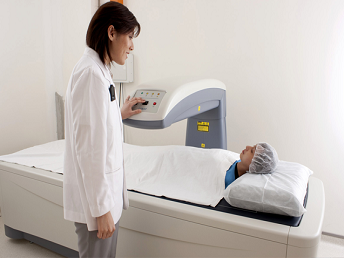DEXA BMD
A DEXA scan is a special type of X-Ray that measures bone density. DEXA stands for Dual Energy X-ray absorptiometry.
DEXA scans, also known as DXA scans are most commonly used to diagnose osteoporosis (where the bones become weak and fragile and more likely to break).
They can also be used to assess the risk of osteoporosis developing. DEXA is also effective in tracking the effects of treatment for osteoporosis or for other conditions that cause bone loss.
A DEXA scan in Kandivali is a high-precision type of X-ray that measures your bone mineral density and bone loss. If your bone density is lower than normal for your age, it indicates a risk for osteoporosis and bone fractures. DEXA stands for dual energy X-ray absorptiometry. This technique was introduced for commercial use in 1987. It sends two X-ray beams at different peak energy frequencies to the target bones.


One peak is absorbed by soft tissue and the other by bone. When the soft tissue absorption amount is subtracted from the total absorption, the remainder is your bone mineral density. The test is noninvasive, fast, and more accurate than a regular X-ray. It involves an extremely low level of radiation. The World Health Organization (WHO) established DEXA as the best technique for assessing bone mineral density in postmenopausal women. DEXA is also known as DXA or bone densitometry.
Medicare
Medicare Part B fully covers a DEXA test once every two years, or more often if it’s medically necessary, if you meet at least one of these criteria:
1. Your doctor determines that you’re at risk for osteoporosis, based on your medical history.
2. X-rays show the possibility of osteoporosis, osteopenia, or fractures.
3. You’re taking a steroid drug, such as prednisone.
4. You have primary hyperparathyroidism.
5. Your doctor wants to monitor to see if your osteoporosis drug is working.
6. What’s the purpose of the scan?
A DEXA scan in Kandivali is used to determine your risk of osteoporosis and bone fracture. It may also be used to monitor whether your osteoporosis treatment is working. Usually the scan will target your lower spine and hips. Standard X-ray diagnostics used before the development of the DEXA technology were only able to detect bone loss that was greater than 40 percent. DEXA can measure within 2 percent to 4 percent precision. Before DEXA, the first sign of bone density loss might be when an older adult broke a bone.
PREPARATION
1. No calcium supplements 24 hours prior to exam.
2. No restriction on food or drink, no studies with oral or IV contrast the same say.
Subsribe To Our Newsletter
Stay in touch with us to get latest news and special offers.
Address
Row House No. 3, Crystal Lawn Society, Near Suruchi Hotel Thakur Complex, Kandivali (E), Mumbai-400101
Call Us
022-2854 4500/ 2854 4700/ 2854 4646/ 2854 4747/ 9819577304
Email Us
vcareimaging.in

